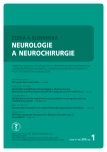Importance of Electromyography in the Reconstructive Surgery of the Upper Extremity
Authors:
I. Čižmář 1; E. Ehler 2; J. Dufek 1; P. Přikryl 1
Authors‘ workplace:
Traumatologické oddělení, LF UP a FN Olomouc
1; Neurologická klinika FZS UPa a Pardubické krajské nemocnice, a. s.
2
Published in:
Cesk Slov Neurol N 2014; 77/110(1): 100-103
Category:
Short Communication
Overview
Aim of the study:
Muscle-tendon transfers are used as part of a complex approach in management of spasticity. The aim of the study was to highlight varied activation of individual muscles in a spastic upper extremity, and to emphasise that it is absolutely necessary to implement a functional EMG assessment before each reconstructive intervention.
Methodology:
Between 2009 and 2012, a group of 17 patients with spasticity of the upper limb was scheduled for surgical reconstruction of the forearm. The mean age of the group was 34 (7–71) years, the mean duration of spastic deformity was 11 (3–24) years. Activity level of the muscles with respect to the position of the hand, involvement when gripping and releasing the grip was assessed using EMG. The aim of the surgery was to eliminate symptoms of spastic forearm muscles during volitional movement of the hand.
Results:
While in a healthy person, forearm muscles are agonistic or synergistic to a specific acral movements, the same muscles showed antagonistic muscle properties in 17% (nine muscles) of the 52 examined muscles of patients with the spastic syndrome. In half of the patients (53%), at least one muscle with antagonistic muscle characteristics – a reverse muscle – was present.
Conclusion:
During hand movement, there are significant differences between patients in how spastic muscles are activated, depending on individual movement patterns. Functional assessment of muscles before reconstructive surgery using EMG provides the necessary information on how to utilize spasticity symptoms (contraction, synkinesis) effectively to achieve a positive effect on the function of the hand grip.
Key words:
elasticity – functional electromyography – upper extremity – tendon transfer
The authors declare they have no potential conflicts of interest concerning drugs, products, or services used in the study.
The Editorial Board declares that the manuscript met the ICMJE “uniform requirements” for biomedical papers.
Sources
1. Reimers J. Functional changes in the antagonists after lengthening the agonists in cerebral palsy. Clin Orthop Relat Res 1990; 253: 30–34.
2. Štětkářová I, Ehler E, Jech R et al. Spasticita a její léčba. Praha: Maxdorf Jessenius 2012.
3. Jankovic J, Albanese A, Attassi ZM, Dolly JO, Hallet M, Mayer NH. Botulinum Toxin: Therapeutic Clinical Practice and Science. Philadelphia: Saunders Elsevier 2009.
4. Barnes MP, Johnson GR. Upper motor neurone syndrome and spasticity. Clinical management and neurophysiology. Cambridge: Cambridge University Press 2001.
5. Ehler E, Vaňásková E, Štětkářová I. Standard komplexní léčby spasticity po cévní mozkové příhodě. Cesk Slov Neurol N 2009; 72/105(2): 179–181.
6. Chambers HG. The surgical treatment of spasticity. Muscle Nerve 1997; 6: S121–S128.
7. Smeulders MJ, Kreulen M. Myofascial force transmission and tendon transfer for patients suffering from spastic paresis: a review and some new observations. J Electromyogr Kinesiol 2007; 17(6): 644–656.
8. Smeuldcrs MJ, Kreulen M. Adaptation of the properties of spastic muscles with wrist extension deformity. Muscle Nerve 2006; 34(3): 365–368.
9. Gracies JM, Bayle N. Vinti M, Alkandari S, Vu P, Loche CM, Colas C. Five-step clinical assessment in spastic paresis. Eur J Rehab Med 2010; 46(3): 411–421.
10. Ward AB. A literature review of the pathophysiology and onset of post-stroke spasticity. Eur J Neurol 2012; 19(1): 21–27.
11. Mayer NH. Choosing upper limb muscles for focal intervention after traumatic brain injury. J Head Trauma Rehabil 2004; 19(2): 119–142.
12. Pilný J, Čižmář I, Ehler E. Transpozice šlachy m. tibi alis posteri or – efektivní řešení parézy perone álních svalů. Cesk Slov Neurol N 2009; 72/105(3): 279–283.
13. Čižmář I, Ehler E, Pilný J, Ira D, Višňa P, Dráč P. Léze radiálního nervu a možnosti pozdní rekonstrukce funkce šlachovým transferem. Cesk Slov Neurol N 2010; 73(6): 701–705.
14. Tafti MA, Cramer SC, Gupta R. Orthopaedic management of the upper extremity of stroke patients. J Am Acad Orthop Surg 2008; 16(8): 462–470.
15. Rosales RL, Kanovsky P, Fernandez HH. What’s the „catch“ in upper-limb post-stroke spasticity: expanding the role of botulinum toxin applications. Parkinsonism Relat Disord 2011; 17 (Suppl 1): S3–S10.
16. Ehler E. Použití botulotoxinu v neurologii. Cesk Slov Neurol N 2013; 76/109(1): 7–21.
17. Welmer AK, Widén Holmquist L, Sommerfeld DK. Location and severity of spasticity in the first 1–2 weeks and at 3 and 18 months after stroke. Eur J Neurol 2010; 17(5): 720–725.
18. Štětkářová I. Mechanizmy spasticity a její hodnocení. Cesk Slov Neurol N 2013; 76/109(3): 267–280.
19. Gellman H, Keenan MA, Stone L. Reflex sympathetic dystrophy in brain-injured patients. Pain 1992; 51(3): 307–311.
Labels
Paediatric neurology Neurosurgery NeurologyArticle was published in
Czech and Slovak Neurology and Neurosurgery

2014 Issue 1
Most read in this issue
- Microsurgical Resection of Symptomatic Pineal Cysts
- Surgical Treatment of Hydrocephalus
- Stiff‑ person Syndrome Associated with Myotonic Dystrophy Type 2 – a Case Report
- International Standards for Neurological Classification of Spinal Cord Injury – Revision 2013
